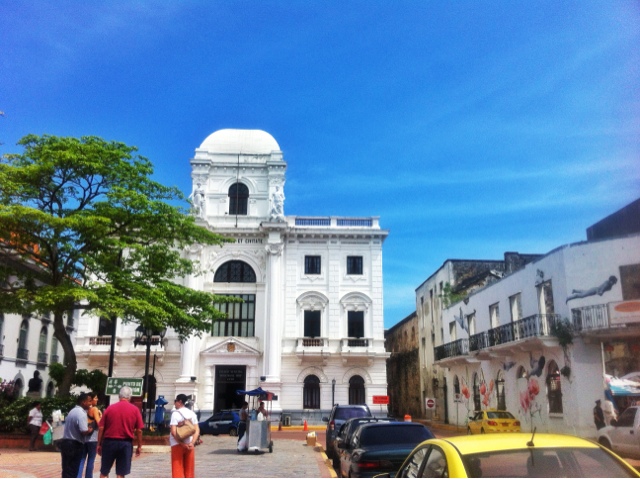Enough about EC. I'm back.
Flying over Panama City's skyline reminded me of Miami's. At first glance, it was certainly more developed than the countries I had just come from.
At the airport immigration, there were twelve large flat screen TVs. They weren't displaying immigration information. Instead, they streamed a cycle of advertisements for the Gap, Visa, etc.
The line for non-Panamanians was much longer than the one for Panamanians, a contrast to what was in El Salvador. There was no visa fee - I believe this was automatically added to my flight cost. The officer took my picture and fingerprints of all ten fingers. He then handed me a brochure - all visitors to Panama, including Panamanians living abroad, get 30 days of free medical insurance. That's a pleasant surprise.
Like El Salvador, Panama uses the US dollar so I didn't have to exchange money. Although, Panama does issue Balboa coins (same values as US coins, but with different imprints) so that gets a little confusing.
Getting into another seemingly illegal taxi, I was soon passing by the high rises I had just flown over. With the exception of a couple buildings, they appeared to mostly be apartments, banks, or hotels, including a bunch of Starwood brands (Sheraton, Le Meriden, etc.). At the base of a group of towers were what looked like a bunch of shanties in various stages of neglect.
The next morning, I found myself in another half hour taxi ride for $12. Despite being much more developed than its Central American neighbors, Panama also had taxis with no seat belt and the fare was by negotiation.
I was heading to the Panama Canal. The entrance fee, including the museum and a 10 minute 3D movie viewing, was $8 for non-Panamanians. I wonder why the US government didn't negotiate a better rate for Americans prior to handing control of the Canal to Panama. I then passed through security, which consisted of handing the guard my daypack and walking through a metal detector. He didn't check my daypack, so the security was a bit weak there.
My timing was impeccable. The movie was just about to get started when I arrived. It was a short piece on the history of the canal narrated by an animated character.
The construction of the Panama Canal was started by France, but the effort failed considerably due to disease (e.g., malaria) and a lack of understanding of the engineering difficulties posed by the mountainous and jungly geography of what was then part of Colombia. After much politics, including the independence of Panama from Colombia, the US eventually took over the construction of the Canal.
Post history lesson, I headed outside to the viewing platform. I was just in time to see the last two ships of the morning pass through the Miraflores locks. With the speed of a snail, each ship moved through the locks with the guidance of mules, locomotives running along tracks laid out on each side of the Canal.
With the ships through, I then found out that the museum was closed. I guess that didn't factor into the pricing.
I briefly returned to the hostel since that was my reference point. From there, I headed to Cinta Costera, the waterfront boulevard that goes along the Bay of Panama and eventually leads to Casco Viejo. Running parallel to the boulevard is a park, which has quite a number of exercise machines dotted throughout. As it was the afternoon, and the sun was out in full force, the boulevard was quite empty. Nevertheless, it was heavily guarded by the national police in black uniforms.
After passing through the harbor, some smelly sewage, a local market, and the central avenue lined with stores, I found myself in Casco Viejo, the former heart of Panama City. With the expansion of Panama City out east, Casco Viejo saw its more affluent residents escape out east as well. Casco Viejo is a UNESCO World Heritage Site and is undergoing a lot of construction / gentrification to restore the colonial, French, and Caribbean architectural buildings that lie there.
By the time I walked back to the hostel, it was time for dinner. There weren't many options for food that were opened, so I grabbed a quick bite from one of the local chains...
Next up - 4 days out in the Caribbean Sea.


































0 comments:
Post a Comment
Don't be shy, share your thoughts! Just be polite :)